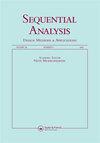A Sequential Test of Traffic Intensity for the M/M/1 Queueing System
IF 0.6
4区 数学
Q4 STATISTICS & PROBABILITY
Sequential Analysis-Design Methods and Applications
Pub Date : 2023-07-03
DOI:10.1080/07474946.2023.2204888
引用次数: 0
Abstract
Abstract This paper deals with testing traffic intensity, which is the most important parameter of the queue system. The Wald-type sequential probability ratio test (SPRT) is performed to determine traffic intensity by taking advantage of the fact that the total number of customers arriving up to the kth service period, including the kth service period, has a negative binomial distribution. Acceptance and rejection limits obtained from the SPRT are arranged as a multiple sampling plan. This plan is applied with a finite Markov chain. Then, the Operating Characteristic (OC) function and the Average Sample Number (ASN) are obtained precisely. Obtaining the standard errors of the sample number compared to the studies on SPRT applications is the novelty brought by this paper. The sequential analysis method based on the finite Markov chain is also applied to a numerical sample.M/M/1排队系统交通强度的序列检验
摘要本文研究了队列系统中最重要的参数交通强度的测试问题。利用到达第k个服务时段(包括第k个服务时段)的顾客总数呈负二项分布的特点,利用wald型序贯概率比检验(SPRT)确定流量强度。从SPRT得到的接受和拒绝限度被安排为一个多重抽样计划。该方案应用于有限马尔可夫链。然后,精确地得到OC函数和ASN函数。与SPRT应用的研究相比,获得样本数的标准误差是本文的新颖之处。并将基于有限马尔可夫链的序列分析方法应用于数值实例。
本文章由计算机程序翻译,如有差异,请以英文原文为准。
求助全文
约1分钟内获得全文
求助全文
来源期刊

Sequential Analysis-Design Methods and Applications
STATISTICS & PROBABILITY-
CiteScore
1.40
自引率
12.50%
发文量
20
期刊介绍:
The purpose of Sequential Analysis is to contribute to theoretical and applied aspects of sequential methodologies in all areas of statistical science. Published papers highlight the development of new and important sequential approaches.
Interdisciplinary articles that emphasize the methodology of practical value to applied researchers and statistical consultants are highly encouraged. Papers that cover contemporary areas of applications including animal abundance, bioequivalence, communication science, computer simulations, data mining, directional data, disease mapping, environmental sampling, genome, imaging, microarrays, networking, parallel processing, pest management, sonar detection, spatial statistics, tracking, and engineering are deemed especially important. Of particular value are expository review articles that critically synthesize broad-based statistical issues. Papers on case-studies are also considered. All papers are refereed.
 求助内容:
求助内容: 应助结果提醒方式:
应助结果提醒方式:


